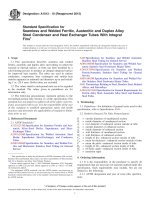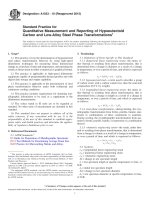Astm d 868 10 (2015)
Bạn đang xem bản rút gọn của tài liệu. Xem và tải ngay bản đầy đủ của tài liệu tại đây (108.03 KB, 3 trang )
Designation: D868 − 10 (Reapproved 2015)
Standard Practice for
Determination of Degree of Bleeding of Traffic Paint1
This standard is issued under the fixed designation D868; the number immediately following the designation indicates the year of
original adoption or, in the case of revision, the year of last revision. A number in parentheses indicates the year of last reapproval. A
superscript epsilon (´) indicates an editorial change since the last revision or reapproval.
1. Scope
3.1.1 bleeding characteristic, n—that condition of discoloration manifested in traffic paint when applied to tar or
asphaltic-type substrates.
3.1.1.1 Discussion—The amount of discoloration can be
comparing the color of the test coating and a specific reference
coating using colorimetric measurements or by visual comparison to the amount of bleeding in a reference photograph.
1.1 This practice describes test procedures for determining
the degree of bleeding of traffic or pavement marking paints. A
specific formulation for a solventborne traffic paint formulation
is included as a potential bleeding reference control.
1.2 The values stated in SI units are to be regarded as the
standard. The values given in parentheses are for information
only.
1.3 This standard does not purport to address all of the
safety concerns, if any, associated with its use. It is the
responsibility of the user of this standard to establish appropriate safety and health practices and determine the applicability of regulatory limitations prior to use.
4. Significance and Use
4.1 Solvents in a traffic paint may cause bleeding of
pavement constituents into the traffic marking, thereby rendering the traffic marking less effective as a lane or directional
indicator. This practice describes how to prepare a panel of the
coating to be tested and a reference panel coated with a specific
solventborne traffic paint to be used as a control for evaluation.
2. Referenced Documents
4.2 This practice can be particularly useful for evaluation of
solventborne traffic paints, but it may also be used for other
types of traffic markings including waterborne traffic paints.
2.1 ASTM Standards:2
D226 Specification for Asphalt-Saturated Organic Felt Used
in Roofing and Waterproofing
D227 Specification for Coal-Tar-Saturated Organic Felt
Used in Roofing and Waterproofing
D476 Classification for Dry Pigmentary Titanium Dioxide
Products
D867 Specification for Pumice Pigment (Withdrawn 1993)3
D1199 Specification for Calcium Carbonate Pigments
D2244 Practice for Calculation of Color Tolerances and
Color Differences from Instrumentally Measured Color
Coordinates
E1347 Test Method for Color and Color-Difference Measurement by Tristimulus Colorimetry
4.3 Two basic procedures are described for measuring the
amount of bleeding. The procedure used shall be agreed upon
by the purchaser and seller.
5. Apparatus
5.1 Film Applicator—A conventional type drawdown gage
that casts a film having a minimum width of 50 mm (2 in.) and
an approximate wet thickness of 380 µm (15 mils) (using an
applicator clearance of approximately 760 µm (30 mils)).
5.2 Test Panel for Coal-Tar Substrate—A 127 by 254-mm
(5 by 10-in.) piece cut from a standard roll of so-called “6.8-kg
(15-lb) coal-tar saturated heat resistant or rag felt.” Unless
otherwise specified, use a Specification D227 coal tar saturated
felt.
3. Terminology
3.1 Definitions of Terms Specific to This Standard:
5.3 Test Panel for Asphalt Substrate—A 127 by 254-mm (5
by 10-in.) piece cut from a standard roll of 6.8-kg (15-lb)
asphalt-saturated felt. Unless otherwise specified, use a Specification D226 (Type 1) asphalt saturated felt.
1
This practice is under the jurisdiction of ASTM Committee D01 on Paint and
Related Coatings, Materials, and Applications and is the direct responsibility of
Subcommittee D01.44 on Traffic Coatings.
Current edition approved June 1, 2015. Published June 2015. Originally
approved in 1946. Last previous edition approved in 2010 as D868 – 10. DOI:
10.1520/D0868-10R15.
2
For referenced ASTM standards, visit the ASTM website, www.astm.org, or
contact ASTM Customer Service at For Annual Book of ASTM
Standards volume information, refer to the standard’s Document Summary page on
the ASTM website.
3
The last approved version of this historical standard is referenced on
www.astm.org.
5.4 Paint Composition for Use as a Control—The paint
composition shown in Table 1 can be used as a control when
applied to 6.8 kg (15 lb) felt. This formulation will show severe
bleeding when applied on a coal tar substrate and a somewhat
lower degree of bleeding when applied on the asphalt felt
substrate.
Copyright © ASTM International, 100 Barr Harbor Drive, PO Box C700, West Conshohocken, PA 19428-2959. United States
1
D868 − 10 (2015)
TABLE 1 Control Paint Formulation for Felt Substrates
Material
Titanium dioxide, TiO2 (Classification D476, Type II, Class II)
Calcium carbonate, CaCO3, conforming to Specification D1199
Aluminum stearate (a 5 % mixture in toluene shall gel at
temperatures below 49.9°C (120°F)
Pumice, No. 100 conforming to Specification D867
Alkyd resin solution, pure oxidizing 52 % modified soya oil, 50 %
solution in 36 K.B. mineral spirits
V.M. & P. naphtha
Lead naphthenate, 24 %
Cobalt naphthenate, 6 %
Anti-skinning agent
Total
direct contact with the test panels. Apply the paint under test at
a thickness to ensure complete hiding.
Weight
Percent
15.40 %
44.00 %
0.15 %
7.3 Keep the coated panel in a flat position until the film is
set (after which the weights may be removed) and allow the
coated panel to dry for 48 h at 21 to 27°C (70 to 80°F).
6.16 %
29.89 %
7.4 Immediately after completion of 48-h drying, determine
the contrast in color between the portion of the film over the
tape and that portion that is in direct contact with the test panels
using one of the following two procedures. The procedure used
shall be agreed upon by purchaser and seller.
7.4.1 Procedure A:
7.4.1.1 Measure color in accordance with Test Method
E1347 in the non-bleed reference area and in the area where
bleeding is allowed to occur. Make these measurements in at
least three positions in both the non-bleed reference area and in
the area where bleeding is allowed to occur. Determine the
ratio between the CIE L* value measured for the area where
bleeding is allowed to the CIE L* value measured in the
non-bleed reference area. Calculate the average of these ratios.
7.4.1.2 Alternatively, determine the delta E in accordance
with Practice D2244 for the area where bleeding is allowed to
occur compared to the non-bleed reference area. Calculate the
average of the delta E values.
7.4.2 Procedure B:
7.4.2.1 Visually compare the contrast between the nonbleed reference area and the area where bleeding is allowed to
occur to the reference photograph in Fig. 1.
3.78 %
0.40 %
0.09 %
0.13 %
100.00 %
6. Preparation of Test Panels
6.1 Cut 125 by 255 mm (5 by 10 in.) pieces from a roll of
coal tar or asphalt substrate. The specimens shall be cut at least
127 mm (5 in.) in from the edge.
6.2 Prepare the non-bleeding contrast surface by attaching a
25 mm (1 in.) of cellophane tape to the coal tar or asphalt
substrate piece using firm pressure. The tape shall be positioned so that the outside edge is at least 25 mm (1 in.) from the
edge and parallel to the edge of the substrate piece.
7. Procedure
7.1 Place the test panel on a smooth flat surface (such as a
glass panel), with the tape side up on the left, and hold in a flat
position by weighting down the edges.
NOTE 1—More consistent results are obtained for the visual comparisons if the same operator makes the evaluations and when the evaluations
are made in an area where the lighting conditions are as consistent as
possible.
7.2 Draw the paint under test down over the specimen panel
in such a manner that the entire width of the tape is covered,
leaving the remainder of the film to the right of the tape in
FIG. 1 Reference Photograph Showing Various Levels of Bleeding of a Traffic Paint
2
D868 − 10 (2015)
8. Report
reference area, or the average delta E of the area where
bleeding is allowed relative to the non-bleed reference area.
8.1.4 For Procedure B, the amount of bleeding based on
comparison to the referenced photograph in Fig. 1.
8.1 Report the following information.
8.1.1 Identification of the traffic paint being tested.
8.1.2 Any deviations from the procedure for preparation of
the test panels from those described in this practice.
8.1.3 For Procedure A, the average ration of CIE L*
between the area where bleeding is allowed and the non-bleed
9. Keywords
9.1 bleeding; traffic paint
ASTM International takes no position respecting the validity of any patent rights asserted in connection with any item mentioned
in this standard. Users of this standard are expressly advised that determination of the validity of any such patent rights, and the risk
of infringement of such rights, are entirely their own responsibility.
This standard is subject to revision at any time by the responsible technical committee and must be reviewed every five years and
if not revised, either reapproved or withdrawn. Your comments are invited either for revision of this standard or for additional standards
and should be addressed to ASTM International Headquarters. Your comments will receive careful consideration at a meeting of the
responsible technical committee, which you may attend. If you feel that your comments have not received a fair hearing you should
make your views known to the ASTM Committee on Standards, at the address shown below.
This standard is copyrighted by ASTM International, 100 Barr Harbor Drive, PO Box C700, West Conshohocken, PA 19428-2959,
United States. Individual reprints (single or multiple copies) of this standard may be obtained by contacting ASTM at the above
address or at 610-832-9585 (phone), 610-832-9555 (fax), or (e-mail); or through the ASTM website
(www.astm.org). Permission rights to photocopy the standard may also be secured from the Copyright Clearance Center, 222
Rosewood Drive, Danvers, MA 01923, Tel: (978) 646-2600; />
3









